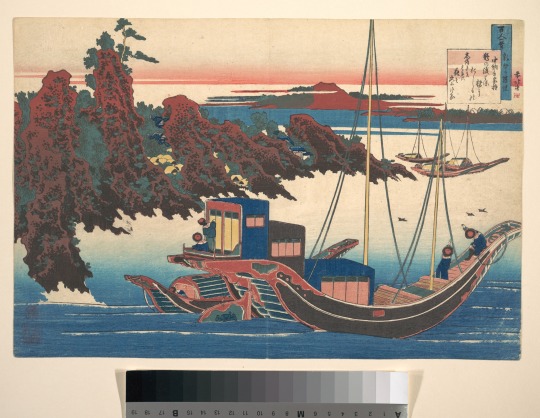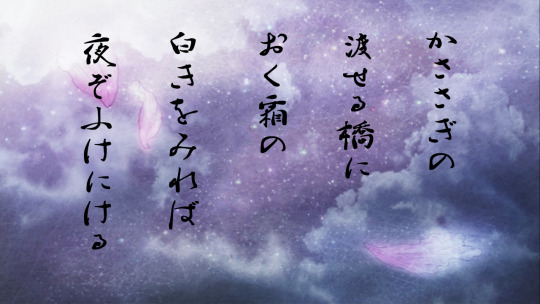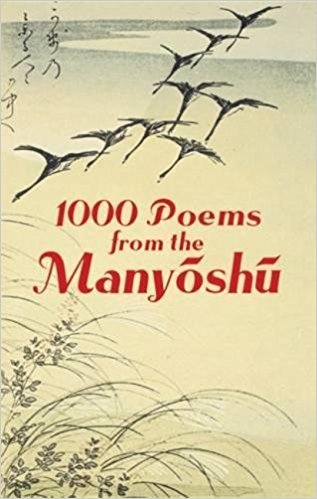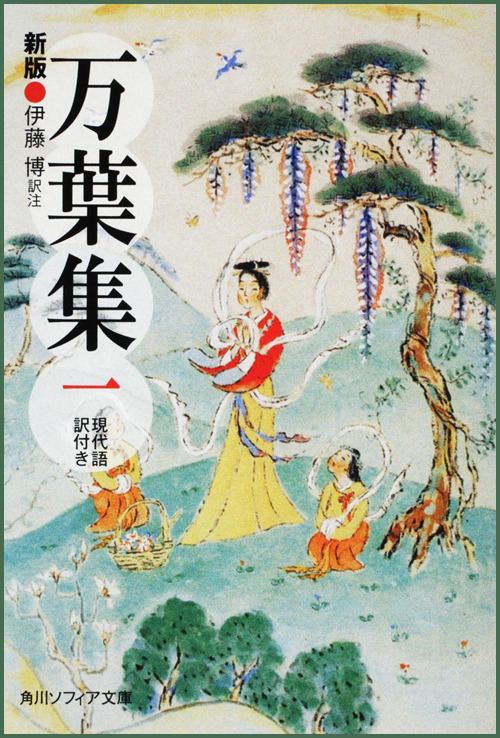#ōtomo no yakamochi
Text










ōtomo no yakamochi, written on the sky; poems from the japanese, tr. kenneth rexroth • kogonada, embodiments of time • ramona ausubel, how to be a writer: the map is the territory • rebecca makkai, the great believers • the dog island. ubisoft, 2007
#im going through it excuse me.#yellowjackets#shaunajackie#yellowjackets blogging#yellowjackets spoilers#IM ROTATING IT IN MY HEAD.
134 notes
·
View notes
Photo

Poem by Chūnagon Yakamochi (Ōtomo no Yakamochi), from the series One Hundred Poems Explained by the Nurse (Hyakunin isshu uba ga etoki). 1760–1849. Credit line: Henry L. Phillips Collection, Bequest of Henry L. Phillips, 1939 https://www.metmuseum.org/art/collection/search/56149
#aesthetic#art#abstract art#art museum#art history#The Metropolitan Museum of Art#museum#museum photography#museum aesthetic#dark academia
1 note
·
View note
Text
THE MANYOSHU

"The Man'yōshū (万葉集, literally "Collection of Ten Thousand Leaves") is the oldest extant collection of Japanese waka (poetry in Classical Japanese), compiled sometime after AD 759 during the Nara Period. The anthology is one of the most revered of Japan's poetic compilations. The compiler, or the last in a series of compilers, is today widely believed to be Ōtomo no Yakamochi, although numerous other theories have been proposed. The chronologically last datable poem in the collection is from AD 759. It contains many poems from a much earlier period, with the bulk of the collection representing the period between AD 600 and 759. The precise significance of the title is not known with certainty.
The Man'yōshū contains 20 volumes and more than 4,500 waka poems, and is divided into three genres: Zoka, songs at banquets and trips; Somonka, songs about love between men and women; and Banka songs to mourn the death of people. These songs were written by people of various statuses, such as the Emperor, aristocrats, junior officials, Sakimori soldiers (Sakimori songs), street performers, peasants, and Togoku folk songs (Eastern songs). There are more than 2,100 waka poems by unknown authors."

Source
0 notes
Text

Ōtomo no Yakamochi, tr. by Kenneth Rexroth, from Written on the Sky; Poems from the Japanese
#excerpts#writings#literature#poetry#ōtomo no yakamochi#fragments#selections#words#quotes#poetry collection#lit#poetry in translation#typography#japanese literature#japanese poetry#love#longing#sadness#dream#separation#hands#heartbreak
1K notes
·
View notes
Quote
We were together
Only a little while,
And we believed our love
Would last a thousand years.
Ōtomo no Yakamochi, Love Poems from the Japanese, tr. by Kenneth Rexroth, ed. by Sam Hamill
268 notes
·
View notes
Photo

When I see the whiteness of frost upon the Bridge of Magpie Wings, ah indeed, the night has deepened.
かささぎの渡せる橋におく霜の白きを見れば夜ぞふけにける
Kasasagi no / wataseru hashi ni / oku shimo no / shiroki wo mireba / yo zo fukenikeru
As the night deepens, the dawn nears. At the end of this strange year, may this old image of a deep night bring hope of the dawn already near.
Hyakunin Isshu 6: Ōtomo no Yakamochi (as always, link to the poem analysis is in the notes below)
This is so fresh off the press (well, my keyboard) I’m afraid I’m sharing this too soon, with too many incoherent sentences and lapses in logic. But I have been thinking and hoping that maybe, in this strange time and with Christmas just a day away, this can bring some calm and hope to those in need.
Wishing you a very merry and calm Christmas ✨ Stay safe.
Until the next poem.
#Ogura Hyakunin Isshu#Hyakunin Isshu#小倉百人一首#百人一首#Otomo no Yakamochi#Chihayafuru#ちはやふる#Chihayafuru poems#Chouyaku Hyakunin Isshu: Uta Koi#Japanese poetry#Waka poetry#poetry#Ōtomo no Yakamochi#大友家持#poetry in translation
19 notes
·
View notes
Text
“POEM”
by Ōtomo no Yakamochi
Meeting in dreams
Is painful indeed.
Starting awake
And reaching out,
The questing hand finds nothing.
35 notes
·
View notes
Quote
Mist floats on the Spring meadow.
My heart is lonely.
A nightingale sings in the dusk.
Ōtomo no Yakamochi, from “Mist floats”; One Hundred Poems from the Japanese (tr. by Kenneth Rexroth)
262 notes
·
View notes
Quote
We were together only a little while, and we believed our love would last a thousand years.
Ōtomo no Yakamochi, Love Poems from the Japanese, tr. by Kenneth Rexroth, ed. by Sam Hamill
13 notes
·
View notes
Quote
Meeting in dreams
Is painful indeed.
Starting awake
And reaching out,
The questing hand finds nothing.
Ōtomo no Yakamochi
2 notes
·
View notes
Photo

Two Immortal Poets, Unknown Japanese, 15th century, Minneapolis Institute of Art: Japanese and Korean Art
2 seated men with moustaches and beards; man at left wears white and blue kimono and black cap; man at right wears black and white kimono; has storage box Fragments of very old handscrolls, particularly those with poetic sentiments expressed by aristocrats from Japan’s classical past, became popular for display in tea ceremonies in the 1500s. Here, two famous poets of the 700s are portrayed as though engaged in a poetry competition. Dressed in black, on the right, is Ōtomo Yakamochi, a military general and one of the compilers of Japan’s first great poetry anthology, the Man’yōshū. Yamabe Akahito, on the left, was a courtier who composed much of his poetry while traveling the countryside with Emperor Shōmu. Appearing with these imagined portraits are verses by each poet on the theme of spring. Even though it is clear on distant Mount Makimuku, snow still falls on the trees. —Yakamochi As the tide rises at Wakanoura, crying cranes descend into the new reeds. —Akahito
Size: 11 3/16 x 17 13/16 in. (28.42 x 45.24 cm) (image) 46 15/16 x 23 5/16 in. (119.22 x 59.21 cm) (overall, without roller)
Medium: Ink and color on paper
https://collections.artsmia.org/art/62702/
4 notes
·
View notes
Text
loonelybird added: My favorite colours.
impracticaldemon said: @todayintokyo my current chibi icon has wisteria. i thought of you :)
@loonelybird and @impracticaldemon, I’m always happy to hear from other members of the Wisteria Fandom! :)

I love the wisteria that scatter
At the brush of a cuckoo's wing;
I pluck the petals off and tuck them in my sleeves –
If they stain, they stain.
Poem written by Ōtomo Yakamochi (718-785)
26 notes
·
View notes
Photo

Poet ōtomo no Yakamochi (c.718-785) from page 2A of the printed book of "Thirty-Six Immortal Poets" (Sanjūrokkasen), Kōetsu edition, Hon'ami Kōetsu, Momoyama period, published circa 1610, Harvard Art Museums: Prints
Harvard Art Museums/Arthur M. Sackler Museum, Bequest of the Hofer Collection of the Arts of Asia
Size: H. 34.5 cm x W. 24.1 cm (13 9/16 x 9 1/2 in.)
Medium: Page 2A of a thread-bound woodblock-printed book with paper cover; ink on paper
https://www.harvardartmuseums.org/collections/object/187200
0 notes
Photo

nel tranquillo e sereno sole di primavera si leva alta l'allodola, sono triste e solitario Ōtomo no Yakamochi, Man'yōshū
1 note
·
View note
Video
youtube
海行かば (Umi Yukaba/If I Go Away to the Sea)
Based on a chōka poem by Ōtomo no Yakamochi in the 8th c. collection Man'yōshū (poem 4094). As set to music in 1937 by Kiyoshi Nobutoki (信時 潔 Nobutoki Kiyoshi).
0 notes
Photo



“Man'yōshū (万葉集, man'yōshū?, "Coleção das Dez Mil Folhas") é a mais antiga coleção da poesia japonesa, compilada em torno de 759 d.C., durante o período Nara. Seções desta coleção estão preservadas na biblioteca da Universidade Colúmbia. A antologia é uma das mais reverenciadas dentre as compilações poéticas japonesas. Acredita-se que o compilador seja Ōtomo no Yakamochi , apesar de inúmeras outras teorias terem sido propostas. A coletânea contém poemas de 347[1] a 759 d.C,[2] a maioria deles representando o período posterior a 600. A coletânea é dividida em vinte partes ou livros; este número se manteve na maior parte das coletâneas posteriores. A coletânea contém 265 chōka (長歌, poemas longos?), 4.207 tankas (短歌, poemas curtos?), um tan-renga (短連歌, curto poema conectivo?), um bussokusekika (仏足石歌?) (poemas sobre os caminhos de Buda no Yakushi-ji em Nara, quatro kanshi (poemas chineses), e 22 passagens de prosa chinesa. Diferentemente de outras coletâneas, como a Kokin Wakashū, não há prefácio.
Esta é a primeira grande coleção de poesia nativa do Japão, e foi escrita em caracteres chineses, no final do século VIII “
“ The Man'yōshū (万葉集, literally "Collection of Ten Thousand Leaves", but see § Name below) is the oldest existing collection of Japanese poetry, compiled sometime after AD 759 during the Nara period. The anthology is one of the most revered of Japan's poetic compilations. The compiler, or the last in a series of compilers, is today widely believed to be Ōtomo no Yakamochi, although numerous other theories have been proposed. The last datable poem in the collection is from AD 759 (#4516[1]). It contains many poems from much earlier, many of them anonymous or misattributed (usually to well-known poets), but the bulk of the collection represents the period between AD 600 and 759. The precise significance of the title is not known with certainty.
The collection is divided into twenty parts or books; this number was followed in most later collections. The collection contains 265 chōka (long poems), 4,207 tanka (short poems), one tan-renga (short connecting poem), one bussokusekika (a poem in the form 5-7-5-7-7-7; named for the poems inscribed on the Buddha's footprints at Yakushi-ji in Nara), four kanshi (Chinese poems), and 22 Chinese prose passages. Unlike later collections, such as the Kokin Wakashū, there is no preface.The Man'yōshū is widely regarded as being a particularly unique Japanese work. This does not mean that the poems and passages of the collection differed starkly from the scholarly standard (in Yakamochi's time) of Chinese literature and poetics. Certainly many entries of the Man'yōshū have a continental tone, earlier poems having Confucian or Taoist themes and later poems reflecting on Buddhist teachings. Yet, the Man'yōshū is singular, even in comparison with later works, in choosing primarily Ancient Japanese themes, extolling Shintō virtues of forthrightness (��� makoto) and virility (masuraoburi). In addition, the language of many entries of the Man'yōshū exerts a powerful sentimental appeal to readers...”
< https://en.wikipedia.org/wiki/Man%27y%C5%8Dsh%C5%AB>
#man'yōshū#万葉集#japanesepoetry#old japanese texts#japanese poetry anthology#japanese art#poesia#poesia japonesa#poemas#poemas de amor#love poetry#religious poetry#manyoshu
3 notes
·
View notes